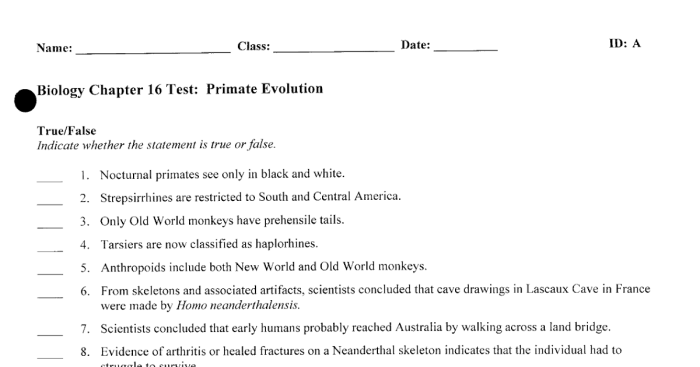With human evolution comparing primates answer key at the forefront, this paragraph opens a window to an amazing start and intrigue, inviting readers to embark on a storytelling journey filled with unexpected twists and insights.
The study of human evolution in comparison to primates holds immense significance in understanding our origins, evolutionary relationships, and unique characteristics. This comprehensive guide delves into the defining traits of primates, the evolutionary timeline of human divergence, genetic and anatomical similarities and differences, and the cognitive and social adaptations that have shaped human evolution.
Introduction: Human Evolution Comparing Primates Answer Key

Studying human evolution in comparison to primates is crucial for understanding our origins and place in the natural world. By examining the evolutionary relationships between humans and primates, we gain insights into the shared ancestry and unique adaptations that have shaped our species.
Primate Characteristics
Primates are a diverse group of mammals characterized by their advanced cognitive abilities, grasping hands, and flexible bodies. They possess large brains relative to their body size, allowing for complex problem-solving and social interactions.
| Species | Physical Traits | Behavioral Traits |
|---|---|---|
| Humans | Bipedalism, large brain, opposable thumbs | Complex language, tool use, social cooperation |
| Chimpanzees | Knuckle-walking, smaller brain, opposable thumbs | Social hierarchy, tool use, hunting |
| Gorillas | Quadrupedal, large body size, herbivorous | Family groups, peaceful interactions |
| Orangutans | Arboreal, long arms, solitary | Fruit-eating, nest-building |
Human-Primate Comparisons, Human evolution comparing primates answer key
Humans diverged from other primates around 6-7 million years ago. We share approximately 98% of our DNA with chimpanzees, indicating a close evolutionary relationship. Despite these similarities, there are significant differences in anatomy, behavior, and cognition.
- Genetic Differences:Humans have a unique combination of genes that have contributed to our upright posture, brain development, and language abilities.
- Anatomical Differences:Humans have a larger brain, a more flexible spine, and a more efficient respiratory system than other primates.
- Behavioral Differences:Humans exhibit advanced social behaviors, such as cooperation, language use, and cultural transmission.

FAQ
What are the key physical and behavioral traits that distinguish primates from other mammals?
Primates are characterized by grasping hands and feet, forward-facing eyes, a relatively large brain, and complex social structures.
How does the genetic makeup of humans differ from that of other primates?
Humans share approximately 98% of their DNA with chimpanzees, our closest living relatives. However, key genetic differences contribute to our unique traits, such as language ability and upright posture.
What are some examples of evolutionary adaptations that have contributed to human survival?
Humans have evolved adaptations such as bipedalism, tool use, and advanced cognitive abilities, which have enabled us to thrive in diverse environments and become the dominant species on Earth.